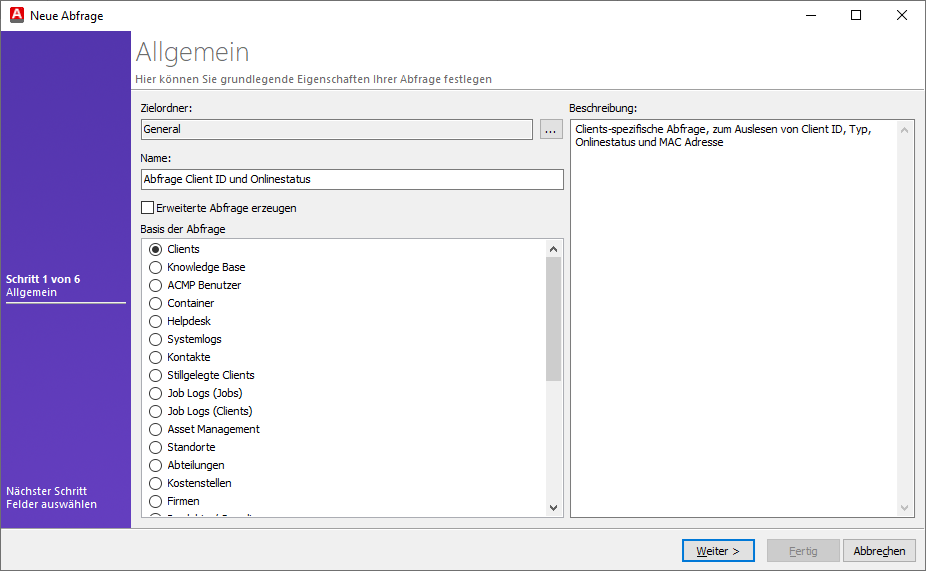Query base
A query base is required when you want to create a new query for the first time. The base is one of the basic properties of a query that you must define on the first page of a new query (General). The base determines which query values are available and what can be explicitly queried in this query.
Example: If you create a client-based query, you will be provided with different fields than with a base that refers to the basics Contacts or Asset Management.
After selecting the query base, you can now select the fields (Display Fields) from the list and include them in the query. For more information, see the section Creating a query with the wizard.

Define query base
Below you will find the available bases for a query and a brief description of the fields they contain.
| Query base | Description |
| Clients | This allows you to call up fields that relate to areas such as the Gateway, document management or the Client's operating system. |
| Knowledge Base | Display fields can be integrated into the knowledge base and the articles it contains (e.g. article keywords, ID or creation date). |
| ACMP users | The available fields include information on ACMP groups (group name) and users (username). |
| Containers | With the ‘Container’ basic function, you can call up container-specific information (e.g. name, priority, path or network status). |
| Helpdesk | Display fields can be selected for the relevant areas of the Helpdesk, such as for stored Assets (name, department, inventory number, etc.) and specific information about the Client, the stored contact and ticket information. |
| Systemlogs | This allows you to call up fields that are specifically related to the system logs. |
| Contacts | Fields in the ‘Contacts’ basic refer to contact information (e.g. name, address, email) and possible information about licenses (license usage). Display fields that refer to tickets can also be integrated via this basic. |
| Retired Clients | Information about deactivated Clients covers various areas: Client details (ID, computer description, etc.) as well as information about the hardware and software used can be read. Various fields can be included using this basic information. |
| Job logs (Jobs) | Using the available fields in the ‘Job Logs (Jobs)’ you can include fields in the query that provide information about the job details (last activities, computer name, distribution ring, etc.) and the job overview (job status, creation date, type, etc.). |
| Job logs (Clients) | The fields in the ‘Job Logs (Clients)’ allow you to compile information in a query that relates, for example, to the client details or to general information about the job, such as the job type, status messages and last activities. |
| Asset Management | This allows you to call up the fields that are related to Asset Management. These include information about the assets themselves, as well as the linked master data (contacts, departments, etc.), products and tickets from the Helpdesk. |
| Locations | With the ‘Locations’ base, fields can be included in a query that have something to do with the information about the locations themselves, such as the address, contact details or a location specification for the company. |
| Departments | This allows you to call up fields that are directly related to the departments (master data), such as the address and other specific contact details, as well as possible department abbreviations. |
| Cost Centers | This query base shows you the available fields that are related to the cost centres (Master Data), such as the name, email or address. |
| Companies | Similar to the other areas of master data, fields that are specifically related to the company (e.g. company address, customer number or contact details) are referenced here. |
| Products / Compliance | Display fields can be selected for the relevant areas relating to products and compliance (License Management). |
| Software catalog | Using the basic ‘Software catalogue’ you can include fields that reveal information about the licence type, product name and release version. |
| Licenses | The ‘Licenses’ base allows you to include fields in a query that provide information about licenses and companies. |
| Contracts | The fields available via the contracts can be retrieved within a query, for example, relating to the terms of the contract or the contact details linked to the contract (e.g. name, email, etc.). |
| Network Tree | The fields in the ‘Network Tree’ base can be used to display information about the computer domain, host type or source in a query. |
| Windows Update Management | This provides access to fields relating to Windows Update Management. These include fields containing information about updates and declined updates, as well as client-specific information such as the computer domain or computer name. |
| Managed Software | With this base, you can obtain information about Managed Software specific fields within a query. This includes, for example, information about the manufacturer, the latest version and the latest changes to the software. |
| Defender Events | The Defender Events belong to the Defender Management plugin. This allows you to call up display fields of the ACMP Client (MAC address, domain, last update, etc.) and of the Defender Management (including Defender Events). |
| ACMP Gateway Certificates | The fields in the ‘ACMP Gateway Certificates’ basic view can provide information about which certificates were used, their status, the validity period that was set, and which computer domain is affected. |
| ACMP Gateway Revoked Certificates | The fields in the basic ‘ACMP Gateway Revoked Certificates’ can be used to obtain various information about the revocation, such as which computer domain is affected, the serial number or the reason for revocation. |
| Job Logs(Server) | Using the Job Monitor, you can create a custom query that provides more information about the Job Logs (such as the result) or the status of the job. |
| Intune Groups | Display fields can be integrated into the Intune groups, which, for example, display information about the group details or possible app assignments. |
| Intune Users | This allows you to call up fields that relate to the Intune user's details (e.g. group and user type, contact details, etc.). |
| Intune Apps | The ‘Intune Apps’ query base can be used to include specific information about the apps (e.g. app type, assignment type, etc.). |
| Vulnerabilities | A query with the ‘Vulnerability’ base can contain fields that refer to the severity of a CVSS finding and specify the number of affected Clients. |


